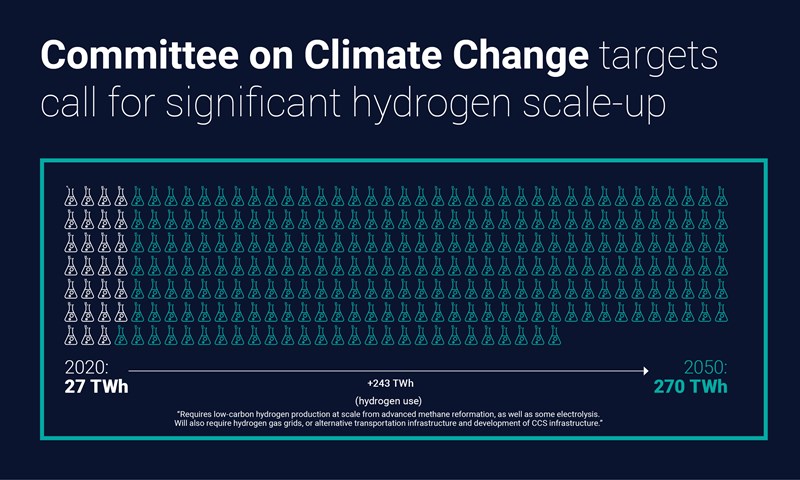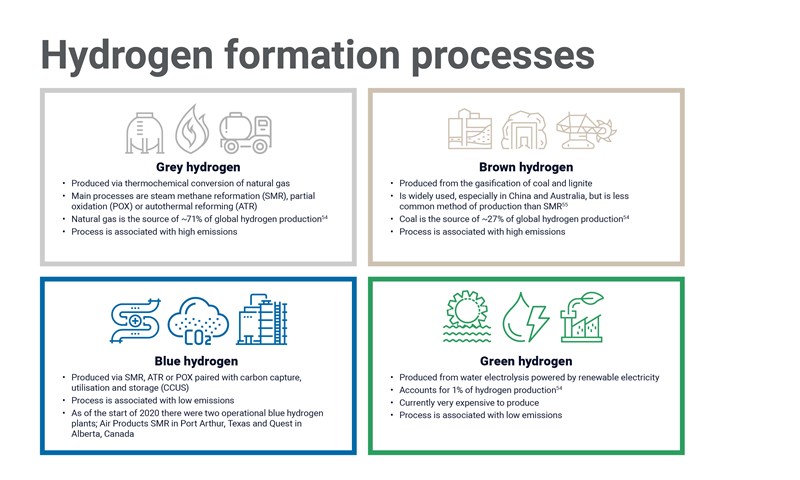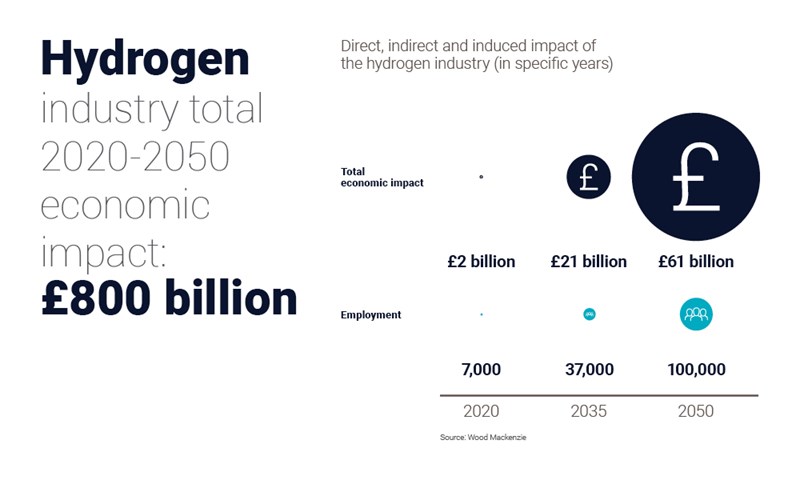Net zero North Sea: can hydrogen live up to its hype?
The UK has an opportunity to be at the forefront of the hydrogen economy – but it calls for rapid technology scale-up
1 minute read
Malcolm Forbes-Cable
Vice President, Upstream and Carbon Management Consulting

Malcolm Forbes-Cable
Vice President, Upstream and Carbon Management Consulting
Malcolm is an expert in designing international growth strategies, unconventional gas studies and portfolio reviews.
Latest articles by Malcolm
-
Opinion
The case for developing UK's oil and gas resources: Rosebank and Cambo fields
-
Opinion
Scotland the brave: a Firth of Forth net zero hub for COP26?
-
Opinion
A £2.5 trillion transformation: the economic impact of a net-zero North Sea
-
Opinion
Is net zero oil and gas production possible?
-
Opinion
Can the UK lead the world in carbon capture, utilisation and storage?
-
Opinion
Net zero North Sea: can hydrogen live up to its hype?
Hydrogen might be the future of energy, but progress to date has been slow. The much-heralded hydrogen economy needs a significant leap forward in innovation to make it a reality – could the UK’s net zero North Sea ambitions provide a push?
This is the second of a five-part series exploring the Wood Mackenzie/OGTC report, Closing the Gap: Technology for Net Zero North Sea. Fill in the form to download the chapter on hydrogen and the path to 2050. Or read on for an introduction to some of the key themes.
Hydrogen needs a major step up to meet net zero targets
In the hunt for a zero-carbon future, hydrogen could be the critical missing link. Abundant, versatile, energy-dense and emission-free (at the point of use), it’s arguably tailor-made for decarbonising hard-to-abate industries. It could supplement or displace other fuels in transportation, heavy industry and many other applications.
But building the hydrogen economy to help realise the net zero vision of the North Sea will require a major build out of capacity. The Committee on Climate Change (CCC) recommends that to meet the net zero target the UK will require to 270TWh of power in the form of hydrogen: equivalent to more than 80% of the UK’s 2018 electricity usage.
Alongside this must come a step up in innovation to develop lower-emission forms of hydrogen generation. Right now, the vast majority of production comes from fossil fuels. Serious investment is needed in blue and green hydrogen.
Accelerating hydrogen technology
As things stand, low-carbon hydrogen is virtually non-existent, and expensive. The industry at large needs to accelerate new technologies to cut production costs.
Grey and brown hydrogen, produced using mainly natural gas and coal, currently dominate. But over the next 30 years blue hydrogen will set the foundation for a low-carbon future. This process pairs fossil-fuel generated hydrogen with carbon capture, utilisation and storage (CCUS) to lower its impact on greenhouse-gas emissions. Blue hydrogen needs investment in improved yield and more efficient CO2 capture to be truly commercially viable.
The holy grail in the longer-term is green hydrogen. This process, using renewable electricity to split water molecules into hydrogen and oxygen via electrolysis, is a true net-zero solution. But it comes with a high price tag. One of the biggest factors is the high capital cost of electrolysers, currently between £640 and £720 per kilowatt.
Scale-up and new automation methods could significantly cut costs. Advances by some leading producers, such as ITM Power, NEL and Siemens, have the potential to reduce capex to between £160 and £240 per kilowatt by 2040. Achievements in solar PV and battery industries have already shown how costs can plummet by scaling up production.
Can the UKCS play a significant role in this escalation? Natural gas resources and extensive capacity for carbon storage in the North Sea mean the region is well placed to exploit blue hydrogen. Meanwhile, its growing number of offshore wind developments will be essential for developing cost-effective saltwater electrolysis to enable green hydrogen production.
Storing and transporting hydrogen: an opportunity to leverage oil and gas industry skills and resources
The ability to store and transport hydrogen safely and efficiently around the world is an essential component of the hydrogen economy. Hydrogen’s versatility means there are many different options, but each presents technical challenges.
Hydrogen can be compressed and transported by pipeline; liquified and stored in cryogenic tanks; or bonded with carrier molecules to create a liquid with a high volumetric energy density from which it can be released at destination or used directly. Alternatively, large volumes of hydrogen can be stored under pressure in underground reservoirs and connected to a pipeline or transport terminal.
There’s a real opportunity to leverage UKCS skills, resources and infrastructure. The existing offshore UKCS pipe network could be used to carry hydrogen, though this has its challenges. For a start, re-lining of pipelines would be required to prevent dangerous leaks.
Extensive salt caverns or depleted hydrocarbon fields under the North Sea are also potential storage sites for hydrogen storage, but this requires research into reservoir rock reactivity and modelling.
There is an unparalleled opportunity for the supply chain to seize a position right at the forefront of an emerging international market.

Malcolm Forbes-Cable
Vice President, Upstream and Carbon Management Consulting
Malcolm is an expert in designing international growth strategies, unconventional gas studies and portfolio reviews.
Latest articles by Malcolm
-
Opinion
The case for developing UK's oil and gas resources: Rosebank and Cambo fields
-
Opinion
Scotland the brave: a Firth of Forth net zero hub for COP26?
-
Opinion
A £2.5 trillion transformation: the economic impact of a net-zero North Sea
-
Opinion
Is net zero oil and gas production possible?
-
Opinion
Can the UK lead the world in carbon capture, utilisation and storage?
-
Opinion
Net zero North Sea: can hydrogen live up to its hype?
The ultimate prize is huge
Can hydrogen fulfil its potential? To play its role in realising the UKCS’ 2050 net zero ambitions a supply chain needs to be in development before 2035. Public and private investment is already underway, but will need to scale up in a coordinated effort to develop economically sustainable solutions.
The effort is needed from end to end – production, transport, storage and end use. And more than £70 billion of UK based capital investment will be required to meet the CCC’s target of 270 TWh of hydrogen supply by 2050.
But the size of the prize is enormous. The opportunity to develop blue and green hydrogen production technologies, alongside novel transportation and storage solutions, offers an unparalleled opportunity for the supply chain to seize a position right at the forefront of an emerging international market.
The UK has an opportunity to become a net exporter of blue and green hydrogen, and an equally valuable chance to export knowledge, skills and innovative technologies. It could also become a centre for international industries looking to decarbonise through offshore fuelling hubs.
There is competition, of course. Other countries, such as Australia, are already utilising their sizeable renewables potential to develop green hydrogen production, and there is a risk that another region can supply hydrogen at a lower cost than the domestic UK market.
However, with its long history of offshore oil and gas production and a world leading renewables sector, the UKCS is uniquely placed. It has the capacity, the infrastructure and the transferrable skills and knowledge to make the hydrogen economy a global success story.
Where are the major obstacles on the hydrogen technology roadmap? How will they be overcome? To find out more, read the hydrogen chapter of our report, Closing the Gap: Technology for a Net Zero North Sea. This includes:
- Production and storage challenges and opportunities
- Hydrogen use on the UKCS – using turbines and fuel cells to decarbonise
- Details on the hydrogen ecosystem and the path to 2050 – including speculative technologies for harnessing hydrogen’s energy potential



